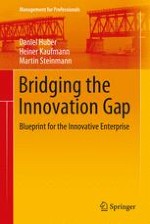2017 | OriginalPaper | Buchkapitel
5. The Organizational Structure: The Innovative Enterprise
verfasst von : Daniel Huber, Heiner Kaufmann, Martin Steinmann
Erschienen in: Bridging the Innovation Gap
Aktivieren Sie unsere intelligente Suche, um passende Fachinhalte oder Patente zu finden.
Wählen Sie Textabschnitte aus um mit Künstlicher Intelligenz passenden Patente zu finden. powered by
Markieren Sie Textabschnitte, um KI-gestützt weitere passende Inhalte zu finden. powered by
